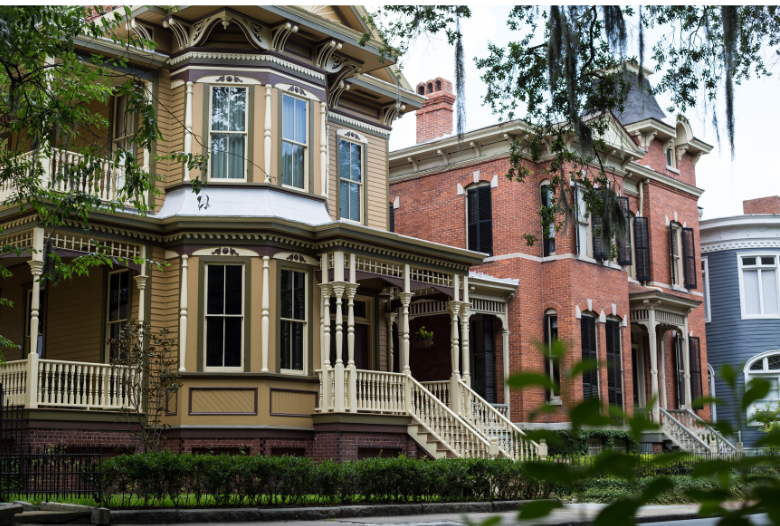
Many homebuyers dream of owning a piece of history. From charming historic districts to one-of-a-kind architectural gems, over 95,000 properties in the United States qualify for the coveted National Register of Historic Places.
Historic homes are often located in sought-after neighborhoods, possess gorgeous design features, and qualify for tax credits. But these homes can be expensive to maintain and are often subject to strict preservation guidelines. They also require special homeowners insurance coverage.
If you own a historic property or are thinking of purchasing one, make insuring your investment a top priority. Without proper coverage, you could be out tens of thousands of dollars (or more) if your home sustains significant damage.
Take the case of a fairly nondescript Frank Lloyd Wright house that was hit by a hailstorm. The roof was the only known example of Wright’s use of welded copper panels, and it had to be replaced. To the tune of $1 million! The good news is the owner’s insurance paid for it all.
That wouldn’t have been possible if the homeowner hadn’t bought a policy tailored to protect older, vintage homes. Not all insurance companies cover historic homes, and there are several factors that you should be aware of when choosing your coverage. Keep in mind, too, that your premiums will be more than what you might pay to insure a newer home.
Just how old is that house?
The age and condition of a house is a major underwriting consideration, since older homes use building materials that are more expensive or aren’t widely used today. For example, your home may have plaster walls, carved molding, solid-brass fixtures, or stained-glass windows. Older homes also often don’t meet modern building code requirements. Some insurers may decline to cover a home that has old wiring, needs repair, or is on a list of historic properties, citing the high cost and difficulty of replacing materials since historic landmarks must be renovated as originally built.
Keep in mind an old house isn’t necessarily a historic house. The National Park Service approves and monitors historic properties based on an evaluation process that usually begins with a local preservation office. To qualify, a property must be at least 50 years old and connected to significant historical events or individuals; considered the embodiment of a particular master or historic style; or provide important historical information.
Registered homes present their own set of insurance challenges, and it’s best to work with an insurance professional who specializes in historic properties. The process begins with a detailed risk appraisal to determine the age and value of the property. You will then catalogue the condition, types of materials, and features that are present. Be sure the company you select has experience in restoration and can calculate the true cost of rebuilding your home.
Guaranteed replacement cost is a must
It is absolutely essential that you obtain coverage that pays the full replacement cost of the original materials used to build your home. Otherwise, you will have to settle for “similar” or “functionally equivalent” materials. Look for insurers that are willing to restore the home to its original condition (known as “like kind and quality”), regardless of the policy’s limits.
You’ll also want coverage that takes into account the cost to meet newer building codes. Make sure there are no limits on the extra costs required to rebuild in compliance with changes in local codes and ordinances.
Many historic homes have detached garages and outbuildings. The entire property should be part of the appraisal process. A typical homeowners policy has a dwelling limit of 10% to cover the cost of replacing outbuildings. Your insurance professional should adjust the limits to adequately insure your unattached structures. Some insurance companies will insure rare plants and trees on your property, even covering individual plants.
In addition to the house itself, you’ll want the contents properly insured. Many older homes have antiques, rare artwork, and period furnishings. Your insurance professional may suggest separate coverage since the normal sublimits in a policy may be too low. For example, you can add a scheduled personal property endorsement to increase the limits for specific items. Or you may need a fine arts floater, which provides full replacement value and insures against breakage. A floater can cover paintings, sculptures, collectibles, china, furniture, oriental rugs, tapestries, antiques, and other rare items.
Additional considerations
- Choose a policy that covers all perils. You are better off purchasing an “open-perils” policy over one that covers only perils named in the policy, such as fire, wind, hail, theft, etc. However, keep in mind that even an open-perils policy will list exclusions. These may include flooding, earthquakes, mold and fungus. Talk to your insurance professional about the types of perils your policy should cover.
- Make sure your policy will pay full replacement cost for a roof. Standard homeowners coverage reimburses for only the cash value of the roof beyond a certain age. Historic homes often have elaborate roofing that can be quite expensive to restore.
- Consider extra coverage for older pipes and utility lines. Water backup coverage protects against sewer or drain backups. A service line endorsement covers the utility lines that run from your house to the street and that you are responsible for repairing.
- Be sure your policy covers loss of use of the property in case you have to move out while restorations are being made. Because historic homes require specialized materials and highly skilled labor, rebuilding can take longer. Look for coverage that doesn’t have limits on what it will pay.
- Reduce your premiums by increasing your deductibles. You’ll also find insurance more available and affordable if you’re willing to make upgrades to your property. For example, many insurance companies will not insure a house with knob-and-tube wiring, a type of electrical wiring used in century-old homes that can be a safety hazard.
- Look for an insurer that will be your partner. In addition to providing the coverage you need, your insurance company should be able to offer professional risk-management advice and recommend builders and restoration experts to help you maintain your vintage home.
The International Risk Management Institute notes, “It is a rare homeowner who understands the importance of correctly establishing the cost to rebuild his or her residence, and owners of historic homes must become well educated on the importance of establishing the cost that would be required to rebuild their homes.”
While you may not live in a Newport mansion or the Biltmore Estate, you still own a unique slice of American history. Take the time to learn about your home’s history and its place in your community. It’s exciting to know that your property may be a local or national landmark. At the same time, you’ll be helping to establish its value and properly insuring it for generations to come.
